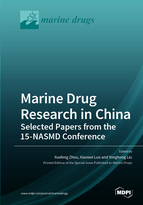Marine Drug Research in China: Selected Papers from the 15-NASMD Conference
A special issue of Marine Drugs (ISSN 1660-3397).
Deadline for manuscript submissions: closed (15 March 2022) | Viewed by 93044
Special Issue Editors
Interests: marine natural product chemistry; drug leads; pharmacological mechanism; marine microorganisms; biotransformation
Special Issues, Collections and Topics in MDPI journals
Interests: marine natural products; secondary metabolites
Special Issues, Collections and Topics in MDPI journals
2. Key Laboratory of Tropical Marine Bio-resources and Ecology, Guangdong Key Laboratory of Marine Materia Medica, South China Sea Institute of Oceanology, Chinese Academy of Sciences, 164 West Xingang Road, Guangzhou 510301, China
Interests: marine organisms bioactive metabolites; marine natural products; marine drugs; marine microorganism; marine fungi; secondary metabolites
Special Issues, Collections and Topics in MDPI journals
Special Issue Information
Dear Colleagues,
For decades, Chinese scientists have contributed greatly to the discovery of new marine natural products (MNPs) with various bioactivities, which have the potential for uncovering new agents to treat human emergent diseases. As a grand event in the field of marine drugs, the 15th National Annual Conference and 2021 International Symposium on Marine Drugs (15-NASMD), sponsored by the Professional Committee of Marine Drugs of the Chinese Pharmaceutical Association and organized by the Institute of Marine Drugs, Guangxi University of Chinese Medicine, will be held in Nanning, China, in 12th-15th November 2021. This Joint Special Issue, which is related to the 15-NASMD), will focus on bioactive natural products from the marine environment, including the following aspects:
- Structurally new and bioactive natural products from marine macro- and microorganisms;
- New strategies or biotechnologies for the discovery of bioactive MNPs or lead compounds of marine drugs;
- Efficacy and pharmacological mechanisms of MNPs;
- Biosynthesis of bioactive MNPs or biotransformation with enzymes;
- Total synthesis and/or structure modification of MNPs.
Please note that registration for the 15-NASMD is required for acceptance. Each submission will enjoy a 20% discount on the APC after acceptance.
Prof. Dr. Xuefeng Zhou
Dr. Xiaowei Luo
Prof. Dr. Yonghong Liu
Guest Editors
Manuscript Submission Information
Manuscripts should be submitted online at www.mdpi.com by registering and logging in to this website. Once you are registered, click here to go to the submission form. Manuscripts can be submitted until the deadline. All submissions that pass pre-check are peer-reviewed. Accepted papers will be published continuously in the journal (as soon as accepted) and will be listed together on the special issue website. Research articles, review articles as well as short communications are invited. For planned papers, a title and short abstract (about 100 words) can be sent to the Editorial Office for announcement on this website.
Submitted manuscripts should not have been published previously, nor be under consideration for publication elsewhere (except conference proceedings papers). All manuscripts are thoroughly refereed through a single-blind peer-review process. A guide for authors and other relevant information for submission of manuscripts is available on the Instructions for Authors page. Marine Drugs is an international peer-reviewed open access monthly journal published by MDPI.
Please visit the Instructions for Authors page before submitting a manuscript. The Article Processing Charge (APC) for publication in this open access journal is 2900 CHF (Swiss Francs). Submitted papers should be well formatted and use good English. Authors may use MDPI's English editing service prior to publication or during author revisions.









